
ManyReach: Make Your City Say “Yes”
You’ve got the skills; Manyreach makes the intros. It finds the right local people and says the right first line so doors open. You’ll book more serious chats with clients who actually want what you sell. It feels simple… because it is.
Friend to friend: a few links are affiliate links. When you purchase, I might get a tiny thank-you from the company, with zero added cost to you. I only recommend things that I’ve actually tried and looked into. Nothing here is financial advice; it is for entertainment. Read the full affiliate disclosure and privacy policy.
You want premium clients in your city. Give me one hour and a clear plan: a clean local list, a short booking funnel, and a Manyreach campaign that feels personal. Then we measure and repeat.
Small-business research shows budgets and channel investments are holding strong this year, so your market is active. Your job is to reach the right people with a useful offer and a clear next step.
Here’s how we’ll do it: a one-hour setup to assemble a city-specific prospect list, an offer page plus calendar with a quick micro-survey, a Manyreach walkthrough
…for clean personalization, and a simple measurement plan for bookings, show rate, CAC, and ROI. Every section includes verified facts, ranges where data varies, and links you can check. – LocaliQ

Your one-hour local client system
Build a clean city list in 30 minutes, then prep fields for safe personalization.
City data sources and a 30-minute list build
Open Google Maps and search by service + city (e.g., “kitchen remodeler Austin”). Pull business names, websites, neighborhoods, and public emails when available.
If you use automation, verify accuracy and respect platform terms; tools can export Maps results, but human review is essential. Chamber or local association directories add verified firms by category.
micro_challenge: Set a timer for 30 minutes. Capture 30–50 businesses across two neighborhoods. Tag each with neighborhood or ZIP so your future icebreakers feel local.
CSV hygiene: required fields and quick validation
Create columns: FirstName, LastName, Role, Company, Website, Email, City, Neighborhood, Note. Keep capitalization consistent and avoid stray spaces.
Manyreach supports renaming up to 20 custom variables and lets you set default text when a field is missing, which prevents broken templates during sends. Example: {{COMPANY | default: "your firm"}}.
quick_win: Paste five rows into a blank CSV and test a merge in a draft campaign before importing your whole file. This catches mis-cased names and missing locations early.
Consent and expectations in outreach
Include a clear opt-out in every message and send only B2B-relevant offers. U.S. CAN-SPAM rules require accurate sender info and an unsubscribe mechanism; EU/UK frameworks emphasize lawful basis and respect for privacy.
Keep records of opt-outs and avoid misleading subjects. – Hunter
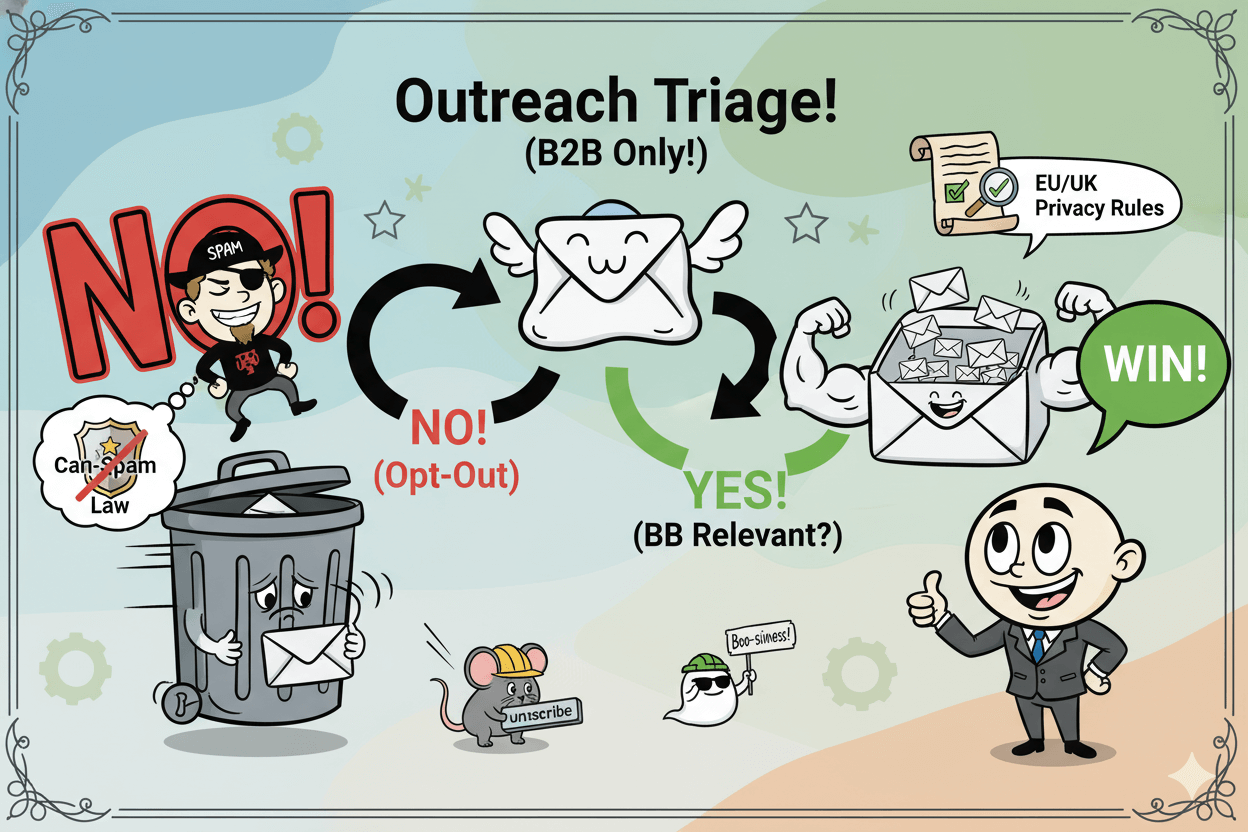
Bridge: With a usable list and safe personalization defaults, you’re ready to craft an offer and a simple booking micro-funnel that converts local interest into scheduled calls.
Craft the irresistible local offer and booking micro-funnel
Two pages to booked: offer that removes risk + calendar with 3 questions.
Free consult vs quiz: when each wins
Use a free consult when the service is high-ticket and custom; your micro-survey should qualify politely with 3–5 questions about timeline, location, and budget range.
Pick a quiz when education is needed; score answers and route high-intent visitors straight to the calendar. Keep form fields minimal and surface social proof near the button.
2025 on-page checklists still emphasize clarity, headings, and scannability—helpful for mobile visitors.
Calendar + micro-survey flow
On the booking page, embed your calendar above the fold. Ask only what helps your first call: service interest, neighborhood/ZIP, timeframe, and one success goal.
Auto-confirm by email and text, then include a reschedule link. Research in 2025 shows text reminders reduce no-shows in service contexts; adapt cadence to your niche and always allow easy rescheduling. – Plivo
Show-rate boosters: reminders and prep
Send three touches: confirmation at booking, reminder 24 hours before, and a same-day prompt with the meeting link and “what to prep.”
In B2B funnels, letting prospects book right after the form can more than double conversion to meetings; locally, the same “speed to schedule” principle helps busy owners lock time while intent is high.
Add a short video on the offer page that previews outcomes and next steps; this aligns with 2025 channel performance.
pro_tip: Put a concise “What happens on the call” checklist beside your calendar. People show up when expectations are simple and useful.

Manyreach setup: city campaign walkthrough
Map city and neighborhood fields, set caps, and schedule in local time.
Campaign and senders: warm, verify, connect
Start with one healthy mailbox, then add more senders to spread volume and protect reputation. Manyreach lets you attach additional senders from Google Workspace, Microsoft 365, or custom SMTP/IMAP.
Add send limits at the campaign level and remember the true ceiling lives at the sender level. Keep follow-ups inside that shared capacity.
pro_tip: Use conservative caps at launch. Example: sender limit 25/day; campaign “initial emails” at 10/day so the remainder supports follow-ups automatically.
Steps and variables: city, neighborhood, event
Import your CSV. In the template, rename custom variables to human labels and use defaults to avoid blanks, e.g., {{NEIGHBORHOOD | default: "your area"}}.
Add unsubscribe using {{UNSUBSCRIBE_LINK}} for built-in copy or {{UNSUBSCRIBE_URL}} to customize wording. This protects compliance and prevents template errors during sends.
myth_buster: Preview emails can hide unsubscribe links in some tools. Live sends include them for prospects; always test with a real external address before scaling.
Schedule and safety: caps, windows, replies
Stack schedules by weekday to mirror local routines. Manyreach supports multiple schedules per campaign so you can test different send windows.
Add an evening or mid-morning slot for service owners who check email outside peak hours. Maintain reply monitoring and stop sequences on positive responses. Include a visible opt-out to meet CAN-SPAM rules.
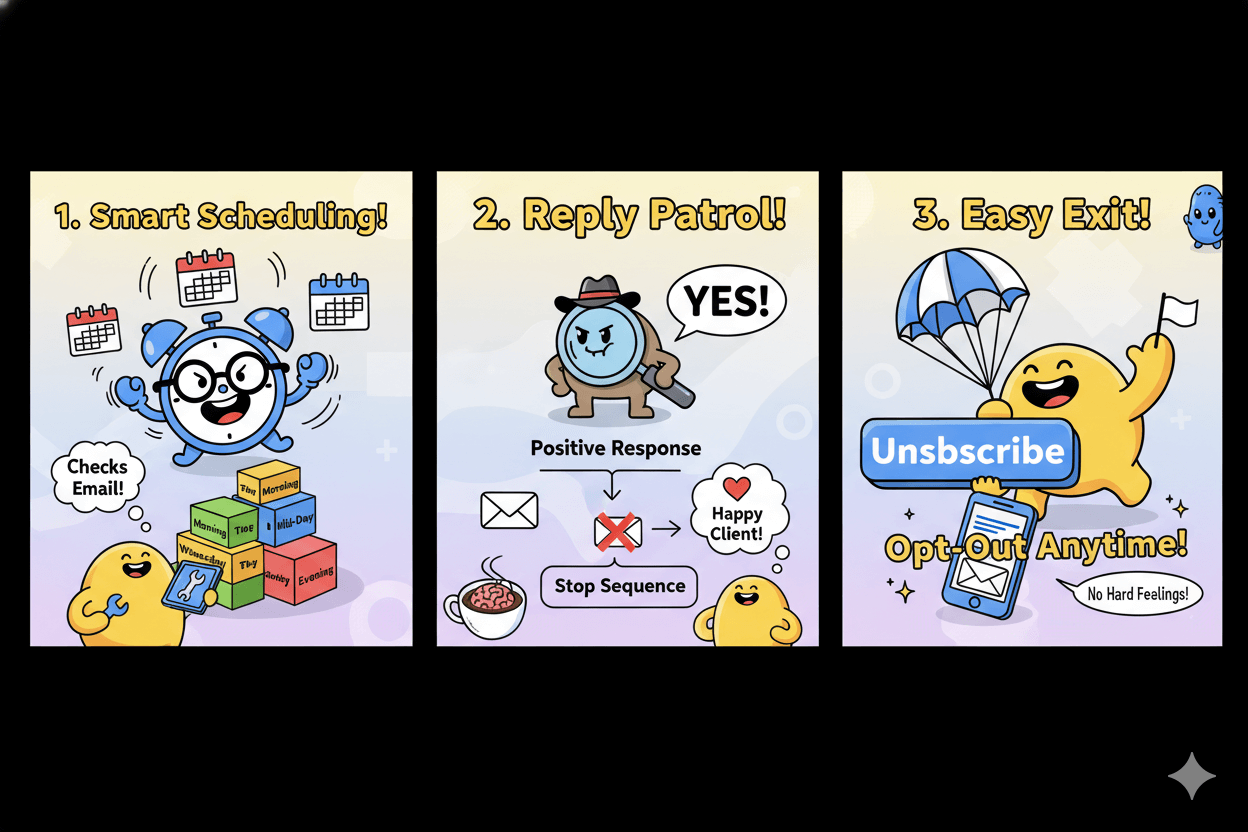
Reality check: Cold email performance differs by list quality and offer. Recent roundups show opens around ~27–42% and replies ~4–7% depending on study and sequence length
…use these as directional only; your city, niche, and proof will drive the final numbers. – Snov Io
Bridge: With your campaign live, personalize first lines with tight local cues so your message feels like it belongs in their inbox.
Personalization that lands: three city icebreaker patterns
Landmarks, events, reviews: three quick icebreakers you can scale today. – Campaign Monitor
Landmarks and neighborhoods
Anchor your opener in something they recognize: “Loved the mural outside your South Congress shop…” or “Congrats on the Ballard expansion.”
You can find safe cues on official sites, Google Maps, and recent news. This moves the message from “random” to “relevant,” which improves the odds of an open and a scan.
For subject lines, research shows that thoughtful personalization correlates with higher open rates; treat your city cue as that personalization, not just a first name tag.
do’s_and_don’ts
Do: name the neighborhood and tie it to a practical benefit.
Don’t: over-compliment or guess private details.
Local events and calendars
Use current events that matter to their buyers: “Planning anything special for Fiesta?” or “Before ArtPrize traffic hits, quick idea to speed bookings.”
Pull dates from city calendars or chambers, then connect your offer to the spike in demand or foot traffic.
Subject-line data suggests clear, specific phrasing drives opens; test a short variant naming the event and a benefit. Keep total length scannable on mobile.
Review-based compliments without fluff
Skim recent public reviews to extract one credible detail: “Noticed three mentions of ‘same-day install’ this month—kept this idea short.”
Quote only a few words and attribute that it’s from public reviews.
Authentic, evidence-framed subjects and first lines earn more attention than generic praise; several 2025 studies highlight higher engagement when the subject conveys proof or specificity.
Pro tip: Prepare merge fields with safe defaults so icebreakers never break when a field is missing. Manyreach supports default values for variables, which prevents empty braces and keeps messages human. Example: {{NEIGHBORHOOD | default: "your area"}}.
Why this works: Personalized subjects are associated with higher opens, and solid benchmarks help you spot when you’re beating the market
…use your local cue to earn the open, then pivot quickly to a helpful, low-pressure next step. Test two versions per send window and log wins.
Follow-ups, cadence, and no-show recovery
5 touches in 18 days, with an easy exit in every email.
5-touch email cadence with soft asks
A balanced cadence for local services: Day 1 intro, Day 3 value add, Day 7 case or proof, Day 12 polite check-in, Day 18 final nudge.
Many practitioners land between two and five follow-ups; some go longer, but diminishing returns rise along with risk. Keep subject lines specific and short. Track reply clustering by touch to tune spacing.
quick_win: If your first two touches get opens but no replies, swap the third email to a proof-first format and remove the CTA to “book now.” Ask, “Worth a 10-minute look?” and let them choose next steps later. Opens ≈ interest; pressure ≠ intent.
No-show recovery script and timing
Speed to schedule matters. Allow prospects to book immediately after a form or a positive reply. In large datasets, instant scheduling from forms materially lifts meeting creation.
Treat this as directional for local services and pair it with reminders. – Chili Piper
For show protection, send three touches: confirmation at booking, 24-hour reminder, and a same-day SMS with the link and reschedule option.
Healthcare and service studies report significant no-show reductions with automated reminders and confirmations; apply the pattern with clear opt-outs.
Reactivation after 30 days
Missed meetings and quiet threads are recoverable. After 30 days, send one polite check-in referencing the original benefit and offering two paths: brief call or helpful resource. Keep it one email only.
Respect prior opt-outs and avoid re-adding unsubscribed contacts. The FTC requires a working opt-out and prompt honoring of requests.
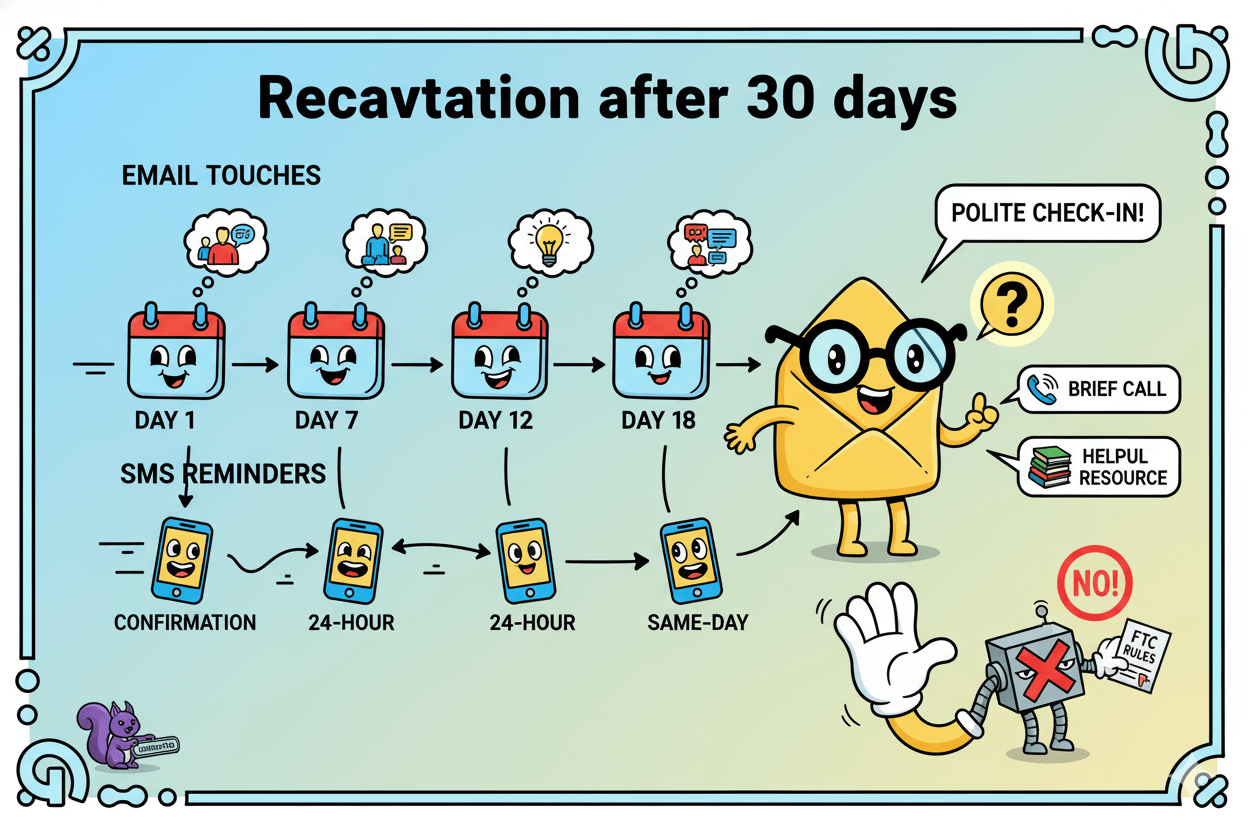
Disclaimer: Provide a clear unsubscribe in every message. Use client-side “unsubscribe” buttons where available to reduce risk for recipients. Laws and platform rules change; verify locally.
Proof that converts: testimonials and before/after
Put a neighborhood-named testimonial beside the booking button.
Risk melts when people see local proof. Show real voices from your city, short and clear. Put proof near the action button, keep captions on, and follow disclosure rules for endorsements.
Reviews matter in local buying, and consumers often check one or two trusted sites before choosing.
20-second vertical testimonial recipe
Record vertical, 1080×1920. Ask one prompt: “What changed after we worked together?” Aim for a single outcome plus a neighborhood cue: “Our Oakwood bookings doubled.”
Add burned-in captions to meet accessibility expectations for prerecorded media. Keep logo small and add a clear “Book now” button nearby for mobile visitors.
Video remains a high-engagement format in 2025, so short beats long here.
quick_win: Capture three takes in five minutes. Pick the tightest version and trim to 15–20 seconds. Export with captions on by default.
Before/after layout with outcome labels
Use a simple two-column block: “Before” on the left with a short description and metric, “After” on the right with the improved metric and timeframe.
Add a one-line neighborhood tag to keep it local. This format reduces decision friction on service pages and aligns with on-page clarity best practices for 2024–2025.
myth_buster: You don’t need a giant case study. One clear before/after with a date and city label works better than vague claims.
Proof placement on offer and booking pages
Put proof where the click happens. On the offer page, place one testimonial video and one review strip above or beside the primary button.
On the booking page, add a compact review row and a tiny before/after block under the calendar. Local buyers rely heavily on a few review sources, so mirror what they already trust.
If any testimonial is incentivized or there’s a material connection, disclose it per FTC guidance.
do’s_and_don’ts
Do: show dates, neighborhoods, and one specific result.
Don’t: edit words into a testimonial or hide incentives.
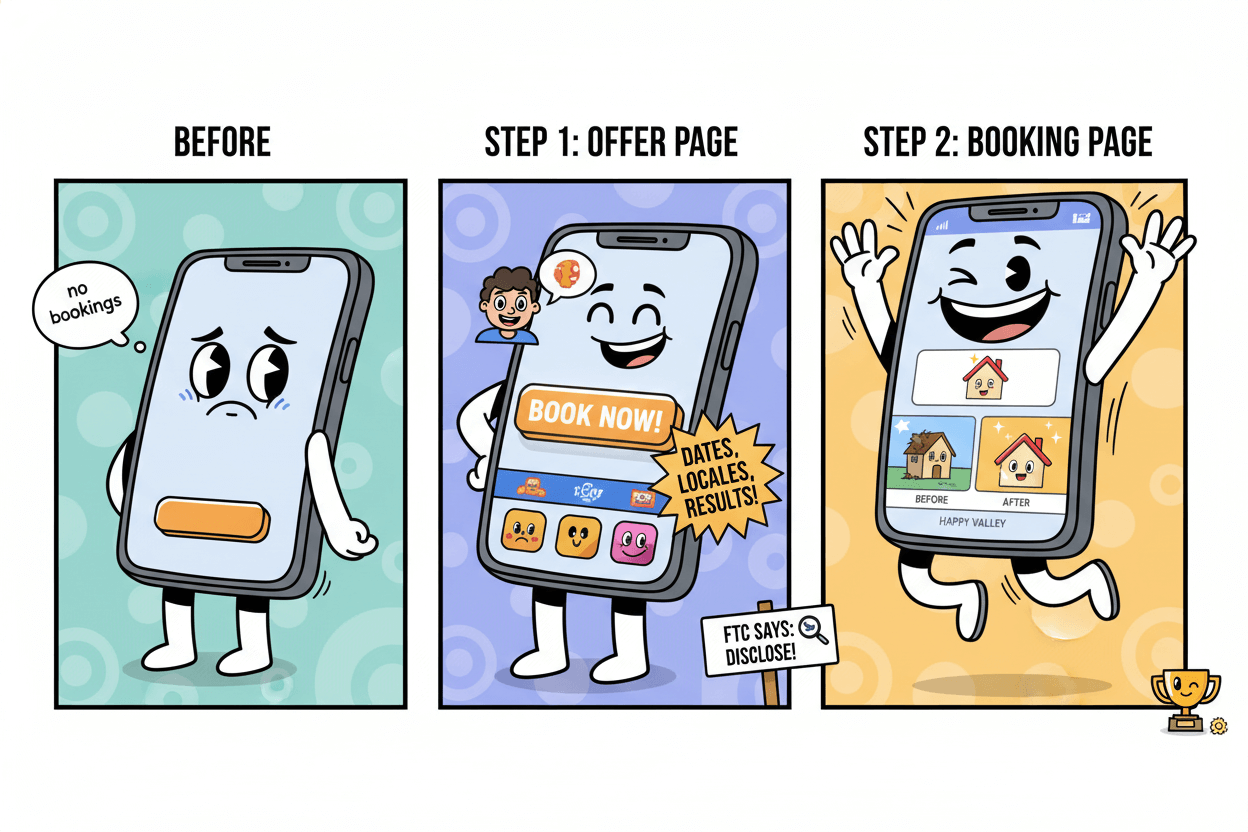
Retargeting and nurture within a 10-mile radius
Build site-visitor lists, aim a 5–10 mile radius, and cap frequency.
Build audiences from visits and no-shows
Implement the Google tag, then create website-visitor segments in Audience Manager. Start with “Visited /offer” and “Visited /book,” plus a 30–60 day “All visitors” list.
If you collect consented phone or email, you can also build customer lists for gentle reactivation. Keep segments simple first; you can layer time windows later.
On Meta, use Website Custom Audiences from your pixel and keep the lookback short for local services where decisions happen fast.
For missed appointments, build a list of “booked but didn’t attend” via your CRM and sync it to show friendly reschedule prompts.
quick_win: If your remarketing pool is tiny, widen the lookback window (e.g., 60–90 days) and run a small daily budget until lists grow. Then tighten to 30 days for higher intent.
Creative that mirrors your city
Use neighborhood names, landmarks, or event references in your headline or first line so the ad “feels local.” Point every ad to the booking page to remove clicks that don’t move the sale.
Local SMB trends show ongoing investment in social and video, so test a short vertical clip that previews outcomes and invites a quick call.
Meta and Google both allow location targeting. In Google Ads you can set proximity targeting with a radius around a point; minimums apply (at least 1 km).
Meta supports country/region/city/radius targeting with clear documentation on how radii behave.
Simple budgets and caps
Begin with one campaign per platform, one ad set/ad group, and daily budgets you can afford for 14 days. Protect audience goodwill with frequency capping.
WordStream calls it “the most fundamental” remarketing control; set daily or weekly caps so your brand reminds rather than stalks.
Use exclusions to avoid waste: exclude purchasers or “booked” URLs, and suppress audiences that already rescheduled. – WordStream
As lists mature, test lookalikes/similar audiences seeded from your best visitors to expand reach efficiently.
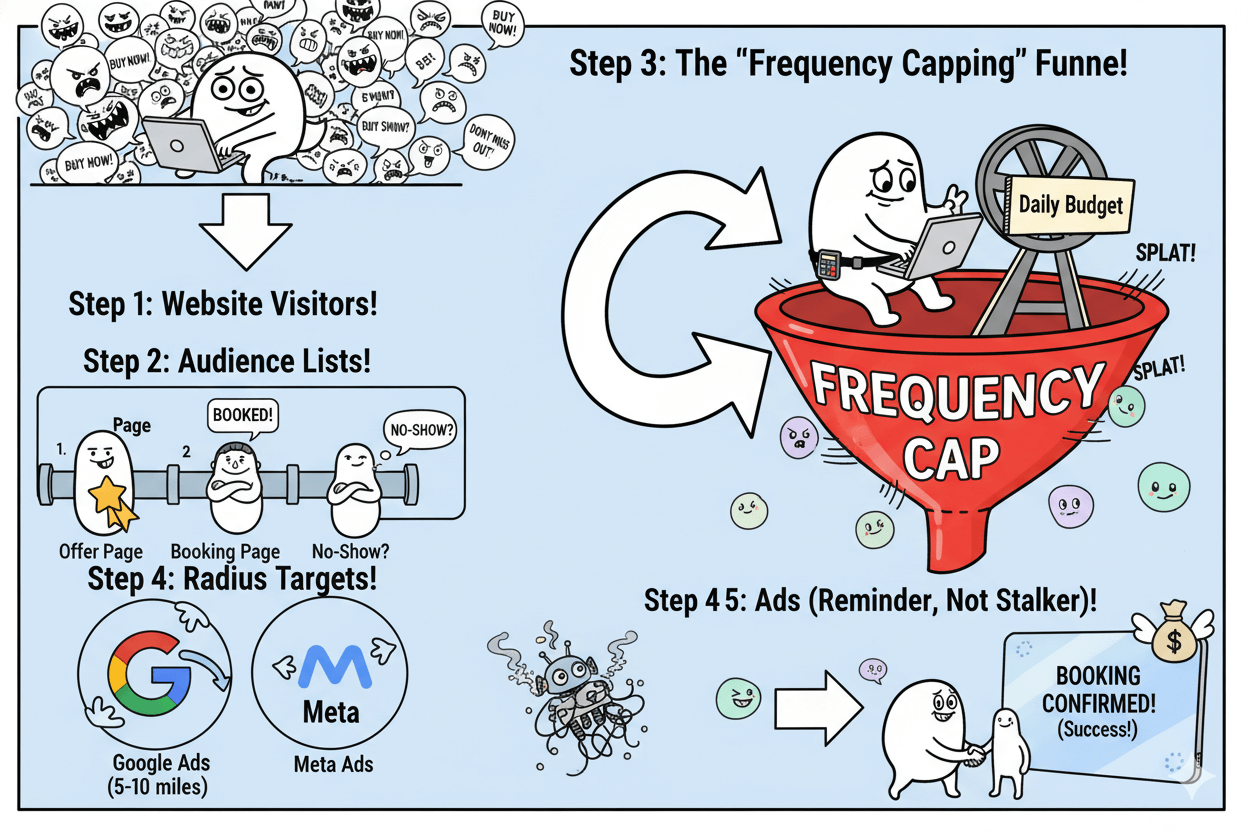
Bridge: With warm locals circling back to your booking page, close the loop by tracking bookings, show rate, CAC, and ROI every week.
Measure what matters: bookings, CAC, and ROI
Weekly view: bookings per 100 sends, show rate, CAC, pipeline value.
Booking and show-rate dashboard
Define the basics in one view:
• Bookings = meetings scheduled from outreach or retargeting in the last 7–14 days.
• Show rate = meetings held ÷ meetings booked.
• Bookings per 100 sends to keep outreach honest.
Add columns for offer page conversion and booking page conversion to spot leaks.
Typical web conversion varies by industry, but mid-single digits are common across many B2B and service contexts, so use your own baselines and focus on week-over-week improvement.
Tie every record to UTMs so you can segment by channel or campaign without guesswork.
pro_tip: Add “City” as a UTM content tag (e.g., utm_content=austin) so you can compare performance across locations without creating separate campaigns. GA4’s URL builder documents the accepted parameters and how they flow into reports.
CAC math with real numbers
Use the standard formula and keep the window short so actions change outcomes:
CAC = (Sales cost + Marketing cost) ÷ New customers in period.
Count only expenses that drove those new customers in the same period. For local services, include ad spend, tools, creative, list prep, and the portion of labor tied to acquisition.
A simple example: if you spent $2,000 this month on outreach and ads and closed 3 new clients, CAC = $667.
HubSpot provides the canonical definition and examples; you can extend it with channel-level CAC if needed, but keep one “blended CAC” for CEO decisions.
myth_buster: There’s no universal “good CAC.” Judge CAC against average deal size and lifetime value. Aim for an LTV:CAC ratio above 3:1 once you’re past early testing.
Weekly review cadence
Every week, fill a one-page sheet: bookings, show rate, booked-to-kept delta, closes, revenue, CAC, and the one bottleneck to fix next. If bookings are low but offer-page conversion is weak, fix the page.
If bookings are fine but show rate lags, strengthen reminders and rescheduling.
Align changes to where your audience already spends time; 2025 channel data shows steady investment in YouTube, Instagram, and TikTok, which pairs well with short proof clips near your CTA.
Re-tag links with UTMs whenever you test a new channel so trends stay clean.
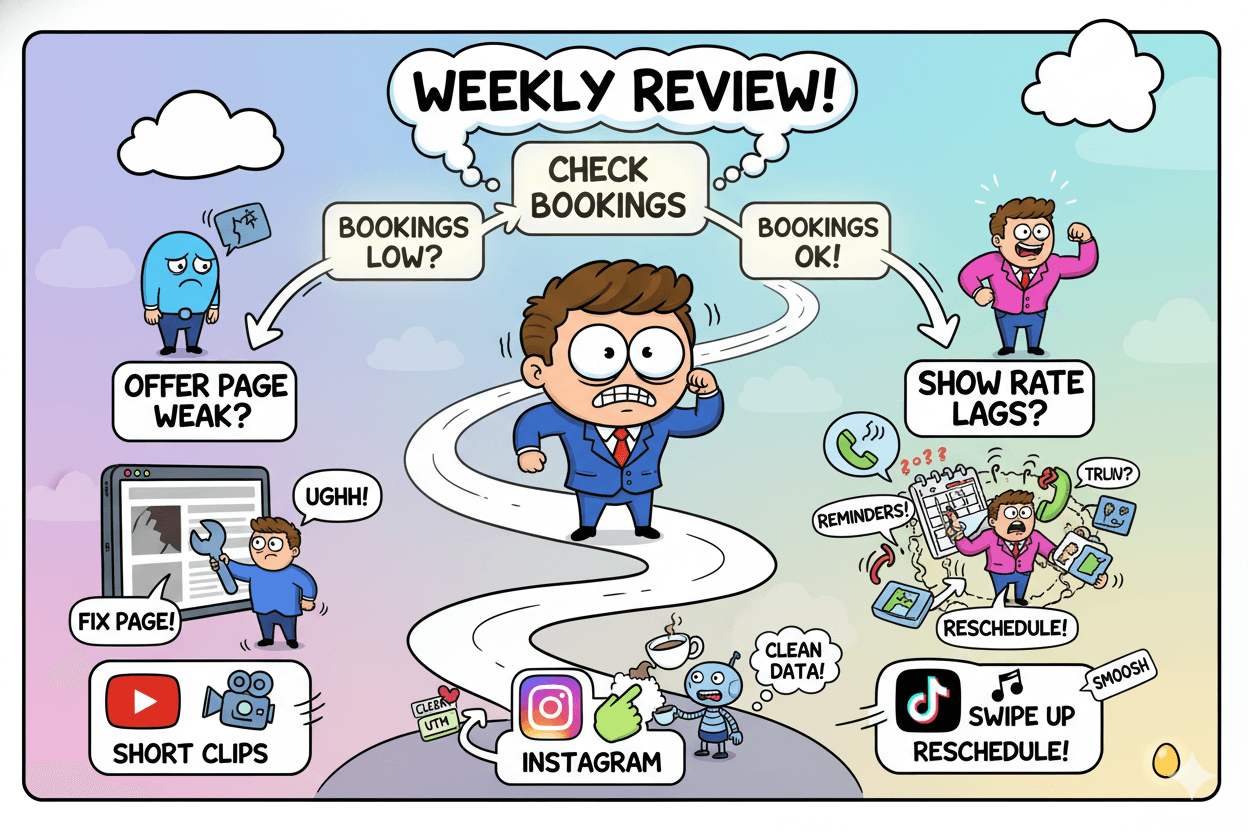
Bridge: You now have a tight loop from send to schedule to revenue. Let’s close with a quick recap and your next action.
Conclusion
You have a simple loop you can run again and again. Build a city list using sources people trust, then keep your CSV clean so personalization never breaks. This keeps targeting aligned to how locals search and choose.
Ship a clear offer and send visitors straight to a booking page. Instant scheduling after a form fill can sharply lift meetings, so make the next step obvious and fast. Use short reminders to protect show rates.
Launch one Manyreach city campaign, map variables with safe defaults, and schedule sends in local time. Keep an unsubscribe in every message. Your goal is helpful first contact, not pressure.
Stay present with a small retargeting budget near your service area. Build audiences from your offer and booking pages, then aim ads at a tight radius or ZIP cluster where allowed.
Platforms support this pattern and document how radii work. Track bookings, show rate, CAC, and pipeline value every week.
Short-form video and social keep pulling attention in 2025, and small-business budgets are still active, so your proof clips and local reviews will meet real demand. Keep UTMs tidy so wins are visible.
Start with one city. When your numbers hold, clone the system to the next neighborhood. Simple, steady, local… that is how you win high-ticket clients in your city.

ManyReach: Neighborhood Fame, High-Ticket Game




